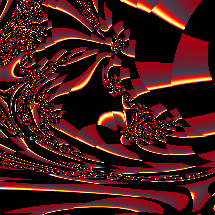
 The
Elastic Fractal – digital image by Noel Giffin. Fractals are generated
with statistical rules for “self similarity”.
The
Elastic Fractal – digital image by Noel Giffin. Fractals are generated
with statistical rules for “self similarity”.
When in this context I made contact with the normal law I was immensely impressed. I found it difficult to believe that this law, rooted in empirical histograms and games of chance, could be part of ordinary everyday mathematics. (p. 70)
At the time we discovered the independence of the cosines, my fascination with the normal law became close to being an obsession. I literally dreamed about it and in my dreams I saw it coming out naturally in contexts close to some kind of physical reality. … “Could it be,” I thought gloomily, “that the normal law will forever be tied to histograms and games of chance?” Then one morning – it must have been late in the spring of 1936 – as I was walking through the park in front of the University’s main building I experienced a quickening of feeling which comes with an idea. “God,” I said to myself, “our cosines! Of course – they obey the normal law.” And indeed they do. (p. 74)
Even before the climax of our search for the meaning of independence was reached, it became abundantly clear why tout le monde was justified in believing in the “loi des erreurs.” It proved to be both “un fait d’observation” and “une theoreme de mathematiques.” (p. 77)
Kac, Mark. Enigmas of Chance, Harper & Row 1987.

